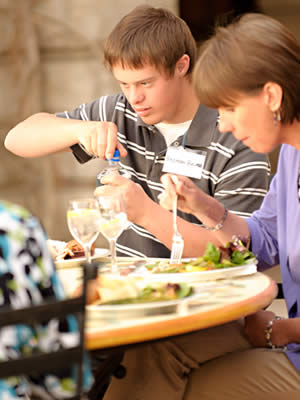Down Syndrome Misconceptions vs. Reality

There are many misconceptions about people with Down syndrome. These misconceptions are largely a result of two contributing factors:
(1) the syndrome itself has changed so fundamentally (for the better) with the dismantling of the inhumane institutions where people with Down syndrome were previously forced to live, and
(2) the lack of medical and basic scientific research makes it difficult to get accurate, updated information about people with Down syndrome.
The Global Down Syndrome Foundation (GLOBAL) is dedicated to correcting misconceptions and over time providing funding for research that will better address medical and cognitive issues associated with the condition.
Misconception: Only older parents have children with Down syndrome.
Reality: According to Centers for Disease Control and Prevention research, about 80% of children who have Down syndrome are born to women younger than 35. The CDC research shows that the chances of having a baby with Down syndrome does increase with age. However, younger women have more babies, so more children with Down syndrome are born to younger mothers.
Misconception: A child with Down syndrome will ruin a marriage.
Reality: A recent Vanderbilt Kennedy Center study published in the American Association of Intellectual Disabilities indicates that divorce rates are lower in families of children with Down syndrome. The study was one of the largest to date and included 647 families who have children with Down syndrome.
Misconception: A child with Down syndrome negatively impacts their siblings.
Reality: Studies do not support that a child with Down syndrome will have a negative impact on siblings. For example, a recent study published in the Journal of Intellectual Disability Research found no long-term detrimental effects to siblings. In fact, some mental health professionals point to the psychological advantages of such a child cared for within the family circle. They have documented siblings who have increased tolerance, compassion and awareness, in contrast to all typical siblings.
The average life expectancy for a person with Down syndrome is nearly 60 years old. Some people with Down syndrome have lived into their 80s.
Misconception: People who have Down syndrome die young.
Reality: The average life expectancy for a person with Down syndrome is nearly 60 years old. Some people with Down syndrome have lived into their 80s. It is true that people with Down syndrome on average don’t live as long as their typical counterparts. Unfortunately, the average life expectancy for an African-American in the U.S. with Down syndrome is just 35 years old. This appalling statistic deserves the full attention of our government and scientific community.
 Misconception: People who have Down syndrome cannot walk or play sports.
Misconception: People who have Down syndrome cannot walk or play sports.
Reality: An inability to walk is not a characteristic of Down syndrome. However, getting early physical therapy to ensure proper walking is important and builds the foundation for sports aptitude. GLOBAL provides sports opportunities through the “Dare to Play” camps. Individuals with Down syndrome have a variety of athletic abilities and levels of agility, in the same way that typical people do. All over the world, there are sports teams that include people with Down syndrome including through Special Olympics.
Misconception: People with Down syndrome can’t read or write.
Reality: The majority of children with Down syndrome can learn to read and write. Research shows that teaching reading to children with disabilities, including those with Down syndrome, is most effective when teachers are well trained, have high expectations of their students, and students’ progress is formally evaluated. More research is needed to determine how to most effectively teach children with Down syndrome to read and write.
Misconception: People with Down syndrome can’t go to regular public schools.
Reality: It is not only advisable that children with Down syndrome attend their public schools, in the U.S. it is required by law that public schools accept and provide an appropriate education to them. This requirement is outlined in the Individuals with Disabilities Education Act (IDEA). IDEA stipulates that all children with disabilities must have available to them a free, appropriate public education that meets their unique needs and prepares them for further education, employment, and independent living.
Further, studies show that including students with disabilities in the classroom improves the academic progress of students without disabilities.
Misconception: People who have Down syndrome don’t feel pain.
Reality: People with Down syndrome absolutely feel pain. Reaction to pain is not always apparent; for example, a 2000 study published in the medical journal, Lancet, suggests that such individuals express pain more slowly and less precisely than the rest of us. Parents and guardians need to be firm with the medical community and insist that people with Down syndrome be given the same types of pain-control procedures as a typical person, even in the absence of obvious signs of pain.
Misconception: People with Down syndrome all look alike.
Reality: Many but not all people with Down syndrome share common features. For example, many but not all people with Down syndrome have almond-shaped eyes and a short stature. However, like typical people who share similar features, they look more like their families than each other.
Misconception: All people with Down syndrome are overweight.
Reality: Not all people with Down syndrome are overweight. However, there is a relationship between Down syndrome and obesity, although the actual degree of obesity relative to the typical population needs further study. According to one study of 247 people with Down syndrome published in the Journal of Intellectual Disability Research, women and men with Down syndrome are more likely to be overweight or obese than compared to the typical population.
Research suggests that both the thyroid and a lower metabolic rate contribute to people with Down syndrome being overweight. This lower metabolic rate means that children with Down syndrome burn fewer calories overall compared to a typical child and need to need to exercise more to burn off the same number of calories. It is important for everyone to eat right and exercise.
 Misconception: All people who have Down syndrome will develop Alzheimer’s disease.
Misconception: All people who have Down syndrome will develop Alzheimer’s disease.
Reality: Numerous studies have shown that virtually 100% of people with Down syndrome will have the plaques and tangles in the brain associated with Alzheimer’s disease (e.g. Zigman et al., 1993, 19, 41-70) but not necessarily the actual symptomatic disease. How many people with Down syndrome will develop the symptomatic Alzheimer’s disease needs additional research. One study from 1989 indicates that between 20-55% of people with Down syndrome will develop symptomatic Alzheimer’s disease before the age of 50 (i.e. Australia and New Zealand Journal of Developmental Disabilities, Haveman et al.,15, 241-255).
Clearly, this is an important area of research for people with Down syndrome and Alzheimer’s and the Global Down Syndrome Foundation is committed to ensuring such research happens.
Misconception: People who have Down syndrome cannot have children.
Reality: It’s true that a person with Down syndrome may have significant challenges in rearing a child. But women who have Down syndrome are fertile and can give birth to children. According to older studies, that are being reinvestigated, men with Down syndrome are infertile. However, it is important to note, there have been a handful of documented instances (see American Society of Reproductive Medicine and Journal of Medical Genetics) of men with Down syndrome who have fathered children.
An increasing number of adults with Down syndrome in the U.S. are living independently with limited assistance from family members or the state. A small percentage are able to live entirely independently.
Misconception: Adults who have Down syndrome cannot live independently or get jobs.
Reality: An increasing number of adults with Down syndrome in the U.S. are living independently with limited assistance from family members or the state. A small percentage are able to live entirely independently. In the U.S. some students who have Down syndrome graduate from high school, and some go on to attend post-secondary education.
More opportunities are available for education and employment today than ever before. Anecdotally, we know that people with Down syndrome can be excellent employees and some employers have reported a higher satisfaction level among ALL workers when they have co-workers who have Down syndrome.
Misconception: People who have Down syndrome are always happy.
Reality: People with Down syndrome are more like typical people than they are different. Everyone has feelings and moods. One recent literature review of previous studies found that people with Down syndrome are at a higher risk for depression. And there is evidence that it is under-treated. Just as in the typical population, it is important that adults with Down syndrome have educational, work and social opportunities, as well as adaptive life-skills.
Misconception: People who have Down syndrome have no memory.
Reality: As any related parent or professional will attest, people with Down syndrome absolutely have memory, and like typical individuals, their ability to remember varies from person to person.
Misconception: Babies who have Down syndrome are a result of incest.
Reality: There is absolutely no relationship between incest and Down syndrome.

 Experience our inspirational and groundbreaking videos and photos. Our children and self-advocates are beautiful AND brilliant!
Experience our inspirational and groundbreaking videos and photos. Our children and self-advocates are beautiful AND brilliant! Make sure your local Representatives are on the Congressional Down Syndrome Task Force.
Make sure your local Representatives are on the Congressional Down Syndrome Task Force.